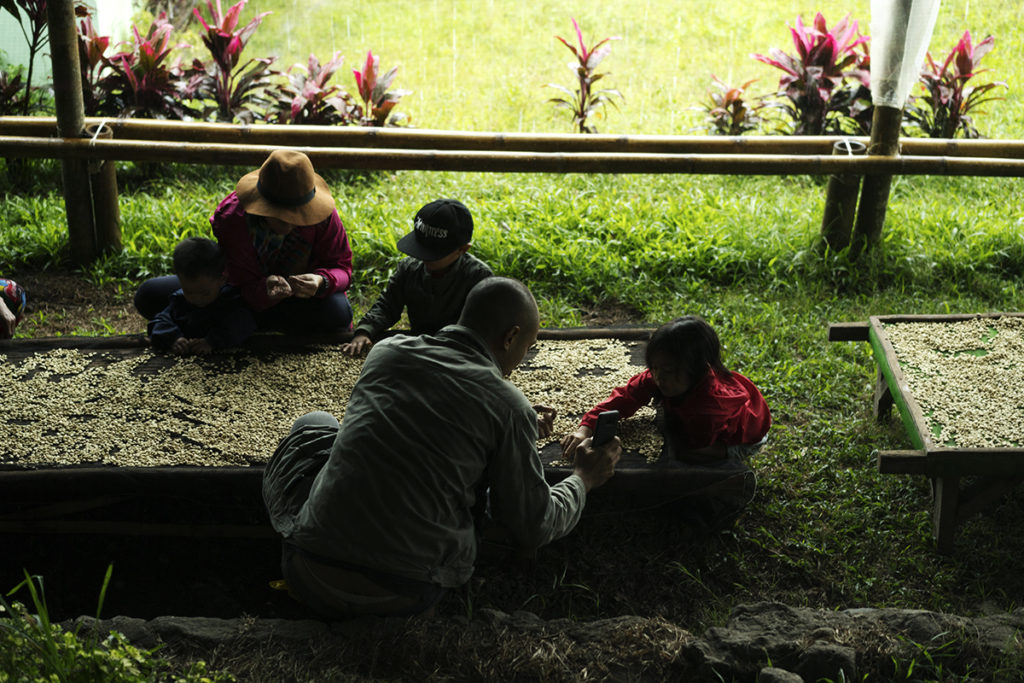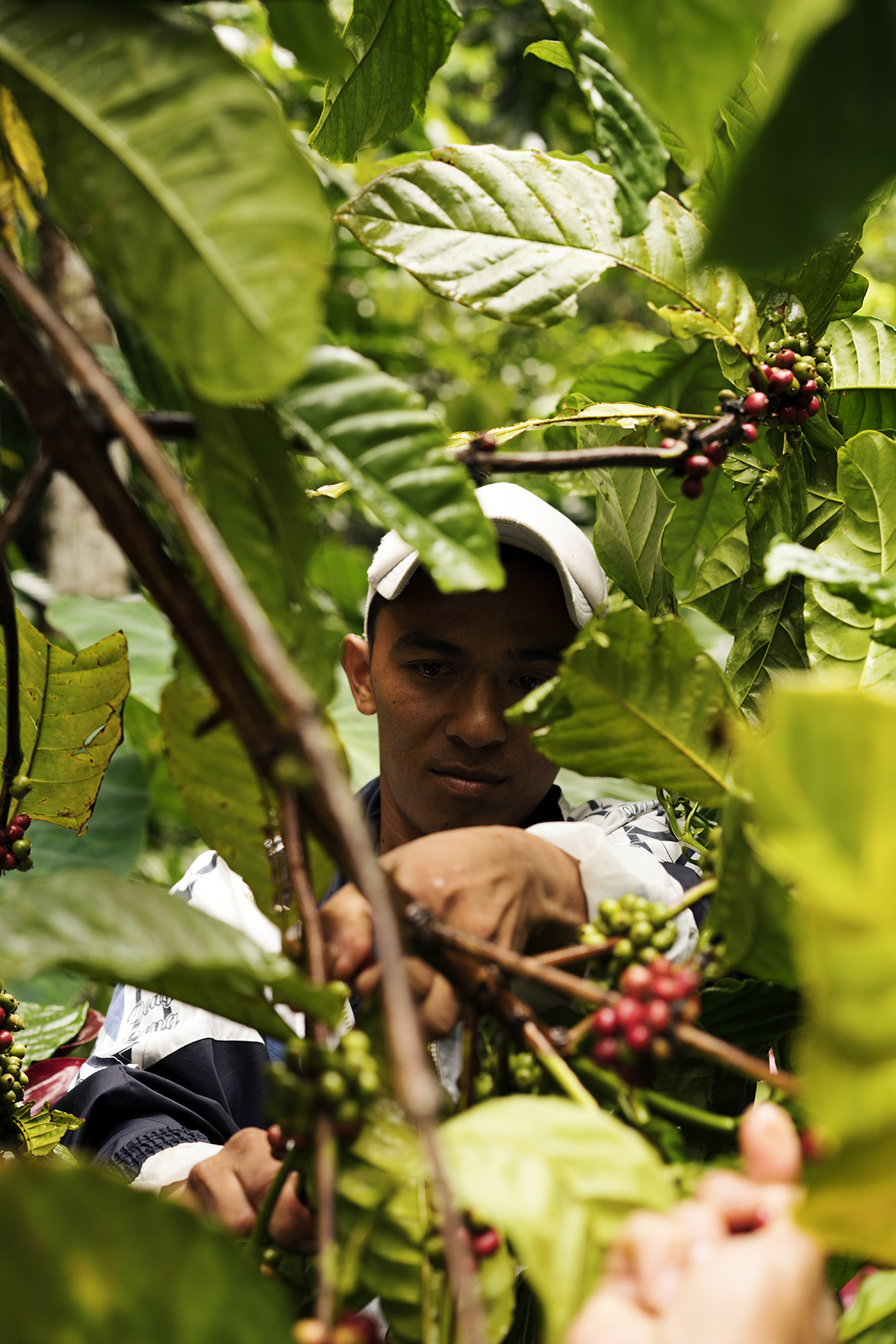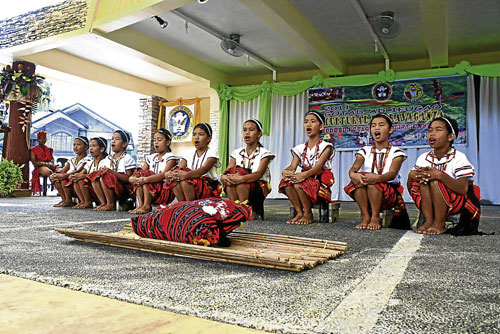No matter how many years you go through it (and most farmers and processors can attest to this), coffee harvest season is always a little bit nerve-racking. You have nightmares about complications. You get phone calls about freak weather. Some things get stolen. Assumptions get thrown out the window. Nothing goes as expected, which is exactly what you come to expect.
Going up the mountain, I usually ride the back of a habal-habal; on my shoulders I carry a bag of my stuff—a bit of fruit, some equipment, a wad of cash. The feeling is always the same as the engine struggles and pulls, the air becomes cooler and the cement houses I see turn to bamboo. I feel like false layers of reality fall away.
Outsider in
I began working in this coffee community years ago after I was contracted as a consultant by a progressive commodities company, Tao Commodity Trader, to explore sustainable ways of doing community-based agriculture. My appetite for uncertainty then was already more than the average person’s—I didn’t expect development to be linear—but my learnings so far still leave me in awe at how little I knew and still know. So I began, with another coffee-processing friend in tow. (Interesting footnote: Most of the specialty coffee processors I know on the ground from all over the country are women. I don’t really know why.)
We don’t realize it, but in many ways, a forest is also insurance to those who live outside it. And yet the people who are the stewards of these forests still struggle to eke out a living.
The Baslay Farmers Association communally owns a dense, wild, completely organic coffee forest (mostly robusta and liberica) that yields luscious red fruit not only for our coffee mill but for bats, birds, civet cats, insects, and a myriad species. They are also caregivers and forest farmers to a growing area of native trees. Their forests yield such gems as kaong, abaca, passionfruit, sayote, and many more. The community is composed of mostly former kaingin (slash-and-burn) farmers who became stewards of the forest on the foothills of Mt. Talinis, which is a DENR-protected area and a buffer zone for a nearby geothermal plant.

Coffee is a seasonal product for the community. Outside of (and also during, actually) coffee season, they make their living doing reforestation, animal husbandry, honey harvesting, and vegetable farming. Some of them keep day jobs as teachers, market vendors, and janitors.
Coming from the “outside” world, or even the field of organic agriculture, it’s easy to walk in with your assumptions about yield per hectare, pruning recommendations, maximizing profitability, and such. But you soon find out that very few of these apply to the forest.
As we’ve come to learn, the forest is not only a biodiversity shelter but it also provides ecosystem services to lowland communities and cities. History has also shown that the scourges of famine and drought have been cushioned by nearby forests, with their wild crops and fruits. We don’t realize it, but in many ways, a forest is also insurance to those who live outside it. And yet the people who are the stewards of these forests still struggle to eke out a living.
Coffee culture

When we started buying coffee cherries, we began at the standard cherry buying price for arabica coffee, which is sometimes double what robusta fetches. But even this was too low for the harvesters, who sometimes walk a few hours to harvest relatively paltry bunches of ripe coffee cherries from trees taller than them. The cherries ripen slowly under the forest canopy, developing sweetness and complexity that can’t be replicated in a plantation. Harvesting wild coffee (and only the red fruit) is seriously challenging for a 33-year-old like me, and we can only hope to make harvesting worthwhile for the harvesters who are almost all older than I am, some twice my age. After a few years, we’ve made peace with the fact that we buy at somewhat outrageous prices, but you can’t put a price on a forest. At the small scale we are at right now, the margins in the coffee industry are healthy enough to absorb the increases.
Cooperate with small entrepreneurs (not just large corporations that can only absorb a certain number of areas) and prop them up too with support, instead of treating them just as middlemen and end-buyers.
After buying the cherries, we float them to get rid of defective beans and then depulp them. All our labor comes from the farmers association, with all members getting to try their hand at it. The next day is spent manually washing coffee, removing the cascara or red skin in preparation for drying. The subsequent drying, which we do in our drying house or on top of portable drying tables, varies according to rainfall, humidity, and temperature. But rain or shine, we need to agitate (or mix around to turn the beans over and aerate all parts) the coffee. After the coffee is dried to our preferred moisture level, we mill the parchment off, sort for defects and size, and store the coffee to rest it. Although our post-harvest setup can be considered rudimentary compared to more commercial mills, people and preparedness make the difference. You can’t think it out if you aren’t there—everything from payments, containers, and contingencies will vary from place to place.

This is the Last Mile. In recent parlance, it means the actual place of technology application. In my mind, it is ground zero of where your food comes from, where actual processes differ from even those farmers describe, where you really have to observe (over seasons) to understand. Lack of investment, or aborted projects, abound in the Last Mile. Government-donated machines gather cobwebs (and house rats). People are wary of buyers who say they will buy things or who make them plant new crops.
That is because you initially believe that you know just what the area needs. And that by next year you’ll have a great operation going. Until you realize that the gaps and challenges are ludicrous—banks are far away; storms ravage your crops and structures; electricity is spotty; people sometimes don’t perform; roads are here today and gone tomorrow; and debts are inevitable because of the insecure, cash-strapped nature of people’s lives. You can’t possibly ask for someone to pay you back after he spends your few thousand pesos for his daughter who got in a motorcycle accident and needed immediate care.
Support system

After years in the project and dealing with small producers for my retail business, I recommend that the government support the farmers with truly free education for their children and reliable emergency healthcare that won’t make them have to search for money and pawn their homes. This will probably keep more people in agriculture, in general.
Also, we can make The Last Mile an area less risky to invest in. Cooperate with small entrepreneurs (not just large corporations that can only absorb a certain number of areas) and prop them up too with support, instead of treating them just as middlemen and end-buyers. Besides, they often have the passion and time to tweak processing, work through challenges, and carve out markets. The processing that happens immediately after harvest often spells the difference between an excellent and a substandard crop, so we need more people on the ground figuring things out, investing in processes, small machines, and labor. Until then, it will remain the domain of crazy folks like us and ruthless middlemen.
As for the coffee, it’s delicious, with a lot of positive feedback from graders, roasters, and consumers. The farmers now drink their own coffee instead of three-in-one. Our demand outstrips supply, and the community seems more ready to be independent in its operations every year. Harvest period is always a little overwhelming, but it’s a small price to pay for bringing people a taste of the forest in a cup.
Originally published in F&B Report Vol. 14 No. 3











































